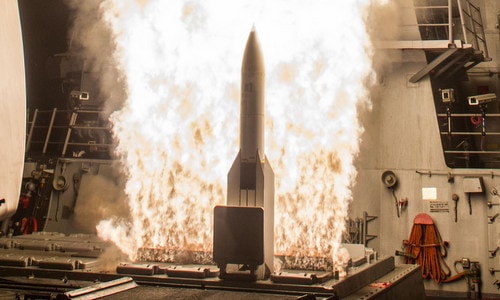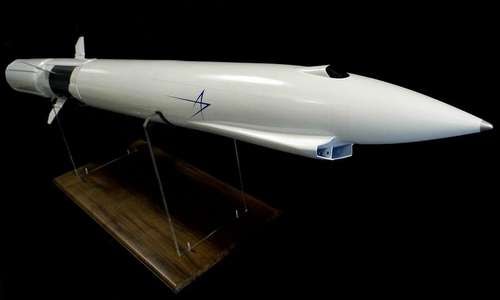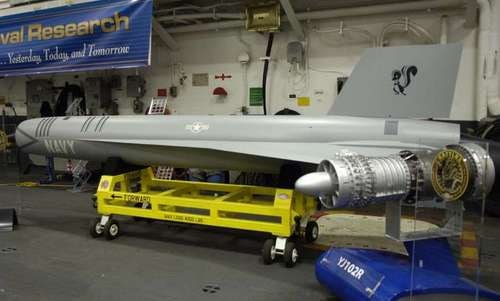Three top-secret US missile designs may have been exposed to Chinese hackers
It is likely that Chinese hackers have stolen important data about hypersonic missiles the US is secretly developing for submarines.
| SM-6 missile tested in 2012. Video:Raytheon |
Washington PostCiting anonymous sources, the US defense corporation's computer network was attacked by Chinese hackers in January-February 2018. The list of lost data includes 614 GB of documents on the "Sea Dragon" program and a secret plan to develop hypersonic missiles for US submarines before 2020.
Although the Pentagon did not reveal the model of the stolen missile, experts said they were part of anti-ship weapons projects that could threaten the operations of Chinese warships, according toDrive.
SM-6 multi-purpose interceptor missile
The SM-6 submarine-launched variant is likely the missile model stolen by Chinese hackers. In 2016, US Defense Secretary Ashton Carter revealed that the Pentagon was improving the SM-6 into a "two-in-one" missile, combining long-range air defense and anti-ship capabilities.
The SM-6 missile uses the SM-2ER Block IV missile's airframe and the AIM-120C AMRAAM's active radar seeker, replacing the semi-active radar seeker of previous SM variants. This allows the missile to intercept highly maneuverable targets, as well as targets beyond the range of shipboard fire control radars.
|
SM-6 missile test launch in 2012. Photo: USNI |
Although only equipped with a 64 kg explosive fragmentation warhead, the SM-6 is still effective in anti-ship missions thanks to its flight speed of nearly 4,300 km/h, creating great destructive power thanks to kinetic energy and not giving the enemy time to activate its defensive shield.
The SM-6 missile can be deployed on Mark 41 vertical launch systems (VLS), making it easily launched from a variety of US submarines.
LRASM-B long-range anti-ship missile
Another anti-ship weapon that could have been stolen by Chinese hackers is the LRASM-B, a supersonic variant developed from the subsonic AGM-158C LRASM missile platform.
|
LRASM-B missile model announced in 2010. Photo:Lockheed Martin |
The LRASM-B version is considered to be as powerful as the BrahMos supersonic anti-ship cruise missile developed by Russia and India. This weapon is especially useful when combined with SM-6 or high-speed anti-ship missiles, forming a multi-layered long-range attack against enemy warship formations.
The LRASM-B program was developed until 2013, when the Pentagon officially terminated the project. It is likely that the LRASM-B design was revived in the Sea Dragon program, which focuses on equipping supersonic anti-ship missiles for submarines instead of surface ships.
RATTLRS high-speed cruise missile
This is a weapons project proposed by the US military with the goal of creating a high-speed anti-ship missile that does not require a complicated launch preparation process. RATTLRS can reach speeds of nearly 5,000 km/h at high altitudes, allowing it to destroy targets within 30 minutes at maximum range. Each missile can be equipped with a cluster explosive, high-explosive or penetrating warhead, depending on mission requirements.
Lockheed Martin developed RATTLRS based on the D-21 supersonic drone with the support of the US Office of Naval Research (ONR) and the US National Aeronautics and Space Administration (NASA). However, this project was terminated in the 2000s when it had just entered the flight testing phase, possibly due to budget cuts.
|
RATTLRS missile prototype in ONR's warehouse. Photo:USNI |
Although it is not yet possible to determine the type of secret weapon stolen, the attack on defense databases by Chinese hackers could pose a serious threat to US national security.
China is investing a lot of resources in the anti-access/area denial (A2/AD) strategy to develop weapons to counter the US Navy, preventing this force from launching a preemptive strike against Beijing. In that context, submarines are the most important tool for Washington to help destroy this strategy.
With the data collected, China can seek to possess the US Navy's offensive capabilities, not just stop at researching defense options, expert Tyler Rogoway emphasized.




